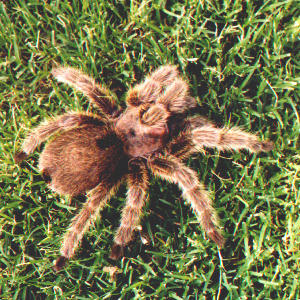



 (Photos by Joel Holmes and Judy Pixley)
(Photos by Joel Holmes and Judy Pixley)




 (Photos by Joel Holmes and Judy Pixley)
(Photos by Joel Holmes and Judy Pixley)
All Phrixotrichus sp. have been changed to Grammostola. G. spatulata is now G. rosea. The G. cala we see in the pet trade is actually a variance of G. rosea (the variant is shown in the photos above; this is the supposed "G. cala"). Supposedly there is a true G. cala, but it is very rare in the wild let alone the pet trade. The pages listed below are supposedly that of the same species (G. rosea) regardless of the author's use of one of the three names for this spider. If anyone has more information, or I have posted the wrong information, please e-mail me.
G. rosea is a hardy species often advised for beginners. There non-aggressive nature and ability to survive make it one of the easiest spiders to care for. G. rosea is an overall brownish-red color (see the above picture for a look of the "G. cala").
G. rosea is very easy to care for. I recommend an either slightly moist substrate (vermiculite works fine, as does pete moss). G. rosea is a opportunistic burrower; they rarely make burrows at all, therefore, a substrate of two inches is more than enough. Supply some kind of a shelter for the spider to retreat to. G. rosea is an unpredictable speceis when it comes to retreats. Mine does not use its retreat at all! Others have reported the use of a retreat, even a little burrowing, but the majority of cases report the wandering tendancies that my subject displays. It is thought that in the wild, G. rosea wanders around at night, finding a retreat during the day (similar to wandering spiders, but not as much wandering). An open water dish is a must for this species, especially if it is kept on a dry substrate (in which case, use a large water dish).
Other strange tendancies for this species is its lack of apitite. My individual eats about one or two crickets a month. I am not sure what this lack of apetite is from; possibly a strange adaptation to captivity? Note that not all individuals are like this. However, ther are a notable number of them that are. If Rose hair doesn't eat much (especially if it is an adult), don't be alarmed.
G. rosea has also been known to skip molts. Out of the two years I've had my rose hair, it has not once shed its skin!
Remember that most G. rosea are fairly docile. However, I have met one irritable one. It was a friend's spider. After looking at it in its glass cage, I decided to try to handle the little guy. As I lowered my hand into the tank, the monster flipped around and bared its fangs in the classic Old World pose! It could have been that it was surprised; maybe my hand startled her? I don't know. What I did learn was to NEVER attempt to handle a tarantula you don't know!
Arachnoid: contains not only origin, husbandry, and diet info, but observations of his own pets
Tarantula Diary: an extensive diary of a rose hair
A second diary from the above web site
ATS: Got to "Articles Online"; "The Chilean Rose Tarantula" by Miep O'Brien
Lelles Tarantula Page (English version): A picture and a good intro
Dave's Tarantula Page: contains no info, but great pics! Wait to load and then scroll down
ArachnoCity: Wayne gives extensive info on rose hairs
Kingdom of the Spiders: Great pictures and a few notes on the "shy" version of rose hairs.
Jason's Tarantula Web: Jason gives a tarantula diary with some good pics.
Rosie's photos: A picture/info on a male rose hair
Deen's Tarantula Page: A good intro into this species
Leon Bienvenue's Tarantula Page: A small intro (scroll down)
Trav's Tarantulas: go to "Species info"; "Our Collection" (listed as G. cala)
Tarantula Terrain: housing and habitat (listed as G. spatulata)
![]()